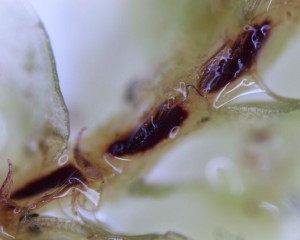Habitat
Gyrothyra underwoodiana tends to grow on mineral soils in sites that are disturbed, such as in recently logged area where they can be found in abundance. Furthermore, they are frequently found in open or slightly shaded areas, typically at lower elevations.
Their distribution is somewhat limited since they are endemic to western North America, along the coast, ranging from southeastern Alaska to northern California.
Gametophyte
Overall structure:
 This leafy liverwort generally forms mat or turfs of shoots that are creeping to suberect. The gametophytes, which tend to fix themselves firmly to their substrate, can range from pale green to pinkish in color depending on where they grow. Generally, in shaded sites, the plants are green, while in exposed areas they can be pinkish.
This leafy liverwort generally forms mat or turfs of shoots that are creeping to suberect. The gametophytes, which tend to fix themselves firmly to their substrate, can range from pale green to pinkish in color depending on where they grow. Generally, in shaded sites, the plants are green, while in exposed areas they can be pinkish.
One of the key distinguishing feature of the gametophyte is the presence of pads that are elliptical in shape and purplish in color. These raised pads are associated with the tufts if rhizoids, which are densely clustered on the ventral surface of the stem.
Leaf:
 The lateral leaves of this species are unlobed and moderately large. A closer look at the leaf insertion will reveal that the leaves are succubus.
The lateral leaves of this species are unlobed and moderately large. A closer look at the leaf insertion will reveal that the leaves are succubus.
Underleaves:
The underleaves on the ventral surface are relatively distinct. Closer observations will show that they are bifid, referring to the “split”. They are much smaller than the lateral leaves and also differ in shape.
Asexual reproduction:
This species is able to reproduce asexually by means of gemmae. These gemmae are unicellular and are present at the apices of the erect shoots.
Sporophyte
Overall structure:
The sporophytes are typically frequent in the spring. The sporophytic features of Gyrothyra underwoodiana are unusual and are useful when trying to identify this species. The lines of dehiscence are arranged spirally on the sporangium. When mature, the four parts of the sporangium uncoils, resulting in the spores and elaters being propelled out.

